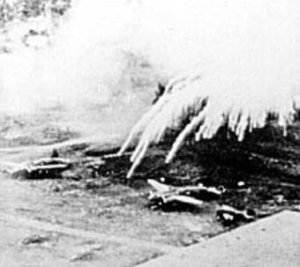![]() The Pacific War Online Encyclopedia
The Pacific War Online Encyclopedia
|
| Previous: Phoenix Islands | Table of Contents | Next: Phuket |
Phosphate is an absolute requirement for all known forms of life. Its most important use is therefore as a component of agricultural fertilizers, though it has many other applications in industry.
Phosphate is obtained either from guano deposits or from phosphate rock , which contains calcium hydroxyphosphate. Rich commercial guano deposits are found on Pacific islands that are high enough to be nesting grounds for seabirds and which are located in dry belts where rainfall will not rapidly wash away the guano. Phosphate rock is more widespread but requires considerable processing because of its very low solubility. Phosphate rock that has been treated with sulfuric acid to increase its solubility is marketed as superphosphate, while phosphate that has been processed with phosphoric acid is marketed as triple superphosphate. Superphosphate had been marketed for decades by the time of the Pacific War, but triple superphosphate was not yet in common use in 1941.
While rice cultivation does not require much phosphate, phosphate
was important for potato and sweet potato production and indispensible
for dry grain production in the cooler parts of Japan. Japan obtained phosphate from Angaur in the Palaus and other islands in the Mandates. These provided 375,000 tons of phosphate rock in 1939, about 32% of requirements. However, the
phosphate
islands of Nauru and Ocean were captured from the British early in the war, and Christmas Island in
the Indian Ocean was raided
and the phosphate stores seized. This
was still inadequate, and production of wheat plummeted in Japan after
1940, when foreign sources of phosphate were embargoed.
The United States
had vast phosphate rock deposits in Florida
and smaller deposits in Idaho, North Carolina, Utah and Montana. Deposits in Tennessee
were
historically important and still producing in 1941, but were nearing
depletion. Phosphate was never a limiting resource for the Americans.

Phosphorus.
Phosphate is a source of elemental phosphorus. Phosphorus is an
allotropic element, existing in several forms. White phosphorus is the
form usually produced, by reduction of phosphate with carbon in the
presence of silica. It is a translucent white waxy solid that
spontaneously ignites on contact with air, producing a thick white
smoke of phosphorus pentoxide. The concentrated smoke is noxious, but
not toxic enough to be considered a poison gas,
and brief exposure of
friendly troops can usually be tolerated. Thus, white phosphorus can be
used to generate a smoke screen. White phosphorus is also useful as an
incendiary. It causes burns if it comes into direct contact with the
skin, and it is highly toxic if ingested or otherwise absorbed into the
body. Phosphorus fragments could be located and removed by immersing the victim in a dilute solution of copper sulfate in a
darkened room. The copper sulfate neutralized the effects of the
phosphorus, which could be located by its own luminescence and removed
with forceps.
American forces used phosphorus grenades
and shells
extensively, primarily as a signal or smoke screen, but also as an
incendiary and as an antipersonnel weapon in confined spaces. The
Japanese also made some use of phosphorus weapons in spite of their phosphate shortage. These included
air-to-air phosphorous bombs, which made an impressive display when
they exploded, but were largely ineffective.
Angaur
Christmas
Garrison
Little Green Monster
References
The Pacific War Online Encyclopedia © 2006, 2008-2010, 2012 by Kent G. Budge. Index